Beneteau Oceanis Yacht 60
By Zuzana Prochazka
A new flagship blends proven ideas with new approches
Photos: Beneteau – Gilles Martin Raget.
Beneteau has introduced a new flagship in their Oceanis Yachts line – the French builder’s category of hulls which are 54 feet and longer. The Oceanis Yacht 60, which is the larger sibling to the only other model in the line, the Oceanis Yacht 54, is a Biscontini-designed hull that replaces the previous 62 and is an evolution of the Beneteau’s direction over the past few years.
The Oceanis 60 has a lower freeboard for less windage, a broader fore-section for more interior volume, and a displacement over five tons lighter than her predecessor for better performance in light winds. The new design also borrows some features from the previous Oceanis Yacht 54 and is an amalgam of new ideas as well as of what’s come before.
On Deck
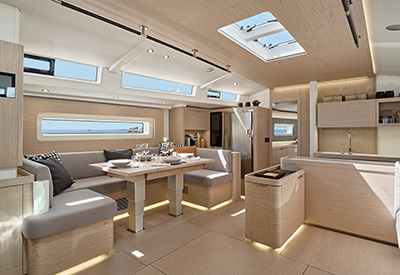
High lifelines run the perimeter of the deck and it’s reassuring to see stanchions this high on an offshore vessel. Less reassuring is the placement of the life raft cubby under the cockpit sole near the companionway. It’s a long way from the transom which means the crew will have to drag the raft a good distance before deploying this heavy lifesaving equipment.
Between the hatches, portlights and the bright wood finish, the interior never feels buried in the hull.
The side decks are wide and clear so traversing from the cockpit to the bow is easy. Aft, there is space to walk behind the helm seats so you never have to climb over the cockpit coaming and on the bow, there’s a nice double sunpad, an ideal place to relax with a book at anchor.
The new cockpit resembles the one on the previous Oceanis Yacht 54 with twin L-shaped settees and hi/lo tables that can raise for outdoor dining or lower into matching sunbeds. The dinghy garage is visible when the transom is lowered and it accommodates a Williams Jet Tender 280. This is similar to the arrangement on the previous Oceanis Yacht 62.
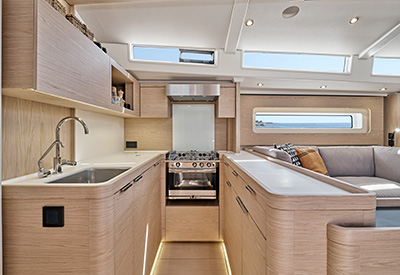
Twin Carbon Nautica wheels are suspended from superyacht-style binnacles which are integrated into the aft ends of the settees. Electric Harken winches are within easy reach from the wheels or they can be operated electrically via switches on the binnacle. A stylish hardtop Bimini protects the cockpit from rain but also has a manually operated fabric sunroof which opens to let the sun and breeze in when desired.
The split galley allows multiple cooks to work simultaneously.
Performance
We motored out of the Miami marina with the 150-hp Yanmar diesel and came up to cruising speed at 2500 rpm and 8.8 knots. The tunnel bow thruster and the drop-down stern thruster by SidePower came in handy when leaving the slip. We popped up briefly to wide-open-throttle at 3600 rpm and 10 knots before slowing to raise the sails.
The Oceanis Yacht 60 offers a choice of a self-tacking jib or a 105% genoa, and a standard rig or the performance version which adds five feet to the mast and 20% to the upwind sail area. Our test boat was outfitted with the taller mast and larger headsail and in 10-12 knots of true breeze on Biscayne Bay, we sailed 7.6 knots at 60 degrees apparent wind angle (AWA).
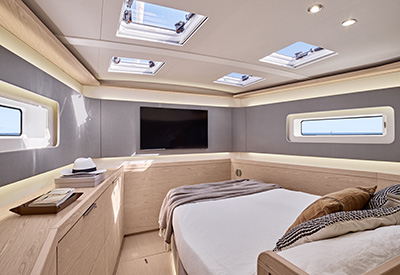
This big boat is built for spicier winds which, sadly, we didn’t experience that day, so we raised the 1,507-square-foot screecher and took off at 9.8 knots on a beam reach. We were able to carry this large downwind sail all the way up to 70 degrees AWA so we kept it flying to have some fun.
The master stateroom bed faces forward and is offset to port for added privacy.
The helm was light and the boat was nimble as we cut through the light chop. With the genoa, our tacks were crisp and quick and the sheets and winches were close at hand. The mainsail is offered with in-mast furling or a traditional hoist and a V-boom which is how our test boat was outfitted. However, the vast majority of buyers are expected to opt for the furler to manage the large (829-square-foot) sail. The Yacht 60 can be sailed easily by two on fast coastal passages but this model isn’t ICW-friendly due to its 80’ 2” air draft.
Accommodations
The Oceanis Yacht 60 is available with only one layout – three cabins and three heads, and also with only two choices of wood finish – light oak or dark walnut. For a semi-custom model, this may sound a bit limiting but Beneteau has dialed in what works for the vast majority of buyers and sticks with their winning formula. Narrowing the personalization choices also makes the construction process more streamlined and efficient.
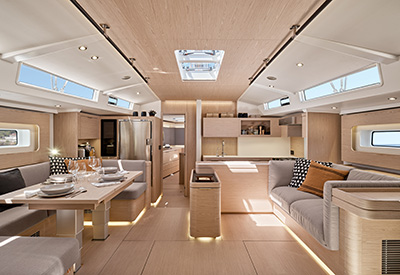
As mentioned above, the Oceanis Yacht 60 leverages elements from other designs and that’s also true when it comes to its living spaces. Like her predecessor, the new model features an enormous navigation desk on the diagonal with a bucket seat, this time found on starboard. It’s a dedicated space ideal for passage planning or working remotely.
With the galley forward, the saloon spreads along the maximum beam with plenty of space to lounge or dine.
Another familiar feature (this time borrowed from another yacht brand) is the split galley that was popularized by Dufour Yachts. The athwartships galley has multiple refrigerator drawers to port, and a sink and stove to starboard. Sizeable countertops are on both sides providing lots of prep space for multiple chefs to work simultaneously.
There are advantages as well as disadvantages to this galley layout. Placing the galley forward provides a buffer between the master stateroom in the bow and the rest of the boat thereby enhancing privacy for the owners. It also allows the saloon to take advantage of the maximum beam of the hull. On the other hand, its orientation makes it difficult to use when sailing, especially on a starboard tack when the cook has no place to brace himself to use the stove or wash the dishes. It’s also quite a distance from the cockpit so handing hot soup up to the crew on a cold passage will involve a long trek especially since there’s a step up from the galley to the saloon that you won’t want to forget.
The master suite is forward and it’s an exceptionally luxurious space which owners will relish. Light and fresh air pour in from four overhead hatches and the ample stowage space includes no fewer than nine drawers. The layout of the cabin breaks from tradition and changes up the placement of the bed which now faces forward and is offset to starboard. By shifting the bed over, Beneteau not only provided a nice walkaround, they’ve also increased privacy because the bed is hidden from view when the door is open.
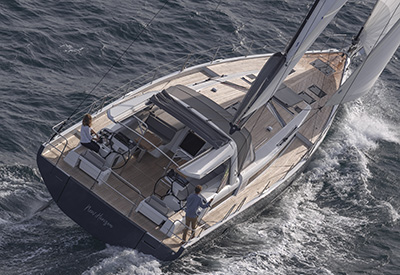
Beneteau includes its proprietary digital switching system called Ship Control to operate onboard electrical systems. Also added is their proprietary Seanapps remote monitoring, geofencing and maintenance alert app. Tech-savvy owners will appreciate both.
the hardtop Bimini adds comfrot to the cockpit in sun or rain and has a manually operated fabric sunroof.
Overall Opinion
Beneteau provides special services with its premium Oceanis Yachts line including 2-3 days of owner training upon delivery, free of charge. Owners who like to make a statement can also opt for a mast that’s painted black to resemble carbon, although it’s aluminum.
The Oceanis Yact 60 is an evolution and a refinement of what has come before as well as a blend of the latest technology and new ideas. Performance-oriented cruising couples looking for luxury will want to test sail this new flagship to see if this is the right blend of ideas for their boating lifestyle.
Specs for Oceanis Yacht 60
LOA/LWL 62’ 2” / 55’ 9”
Beam 17’ 5”
Draft 7’ 3” / 8’ 4”
Displacement 47,840 lbs
Sail Area 1636 sq ft (std)
Power 150-hp (shaft)
Designer BiscontiniYacht Design
Builder Beneteau, beneteau.com
Price as tested $ 1.9 million USD






















